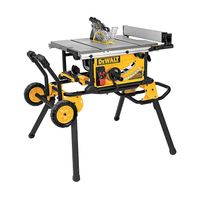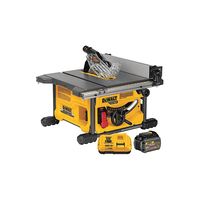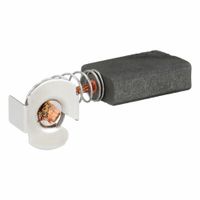Call +(254) 703 030 000 / 751 483 999 / 721 704 777
- Home
- Tools
- Power Tools
- Power Saws Blades
- Table Saws
.....Read More
Frequently Asked Questions
What is the difference between a contractor table saw and a cabinet table saw?
A contractor table saw and a cabinet table saw differ primarily in design, power, and intended use.
1. **Design and Portability**:
- **Contractor Table Saw**: Typically features an open base and is designed to be more portable. It often has a lighter frame, sometimes with wheels, making it easier to move around job sites.
- **Cabinet Table Saw**: Built with a closed, heavy-duty cabinet base, providing greater stability and reducing vibration. It is generally stationary due to its weight and bulk.
2. **Power and Performance**:
- **Contractor Table Saw**: Usually equipped with a motor ranging from 1 to 2 horsepower, suitable for light to medium-duty tasks. It operates on standard 120V circuits.
- **Cabinet Table Saw**: Comes with a more powerful motor, often 3 to 5 horsepower or more, requiring a 240V circuit. It is designed for heavy-duty, continuous use, offering superior cutting power and precision.
3. **Precision and Stability**:
- **Contractor Table Saw**: While capable of accurate cuts, it may experience more vibration, affecting precision, especially in demanding tasks.
- **Cabinet Table Saw**: Offers enhanced precision due to its robust construction and reduced vibration, making it ideal for fine woodworking and professional applications.
4. **Dust Collection**:
- **Contractor Table Saw**: Generally has less efficient dust collection due to its open design.
- **Cabinet Table Saw**: Features superior dust collection systems, aided by the enclosed cabinet, which helps maintain a cleaner work environment.
5. **Cost**:
- **Contractor Table Saw**: More affordable, appealing to hobbyists and small-scale operations.
- **Cabinet Table Saw**: Higher cost, reflecting its advanced features and suitability for professional workshops.
How do I make accurate cuts with a table saw?
1. **Setup and Calibration**: Ensure the table saw is on a stable surface. Check that the blade is sharp and properly aligned with the miter slot. Adjust the fence parallel to the blade.
2. **Blade Selection**: Use the appropriate blade for the material. A fine-tooth blade is ideal for precise cuts.
3. **Safety Gear**: Wear safety goggles, ear protection, and avoid loose clothing. Use a push stick for small pieces.
4. **Measurement and Marking**: Measure the material accurately using a tape measure. Mark the cut line clearly with a pencil or chalk.
5. **Fence Adjustment**: Set the fence to the desired width of the cut. Double-check measurements to ensure accuracy.
6. **Blade Height**: Adjust the blade height so it is slightly higher than the thickness of the material being cut.
7. **Positioning**: Stand to the side of the blade, not directly behind it, to avoid kickback. Ensure the material is flat against the table and fence.
8. **Cutting Technique**: Start the saw and let it reach full speed. Feed the material steadily and smoothly through the blade, maintaining firm pressure against the fence.
9. **Use of Jigs and Accessories**: For repetitive cuts, use a jig or sled to maintain consistency. A miter gauge can help with angled cuts.
10. **Post-Cut Check**: After cutting, check the piece for accuracy with a square or measuring tool. Make adjustments if necessary.
11. **Maintenance**: Regularly clean the table saw and check for any wear or misalignment to ensure ongoing accuracy.
What safety features should I look for in a table saw?
1. **Blade Guard**: A transparent cover that shields the blade, preventing accidental contact while allowing visibility.
2. **Riving Knife**: Positioned behind the blade, it prevents kickback by keeping the cut kerf open and aligning with the blade's movement.
3. **Anti-Kickback Pawls**: These are small, toothed arms that grip the wood if it starts to kick back, preventing it from being thrown towards the operator.
4. **Flesh Detection Technology**: Systems like SawStop detect contact with skin and stop the blade almost instantly, minimizing injury.
5. **Magnetic Switch**: Prevents the saw from restarting automatically after a power outage, requiring a manual restart.
6. **Push Stick/Push Block**: Tools that allow you to guide the wood through the blade while keeping your hands at a safe distance.
7. **Splitters**: Similar to riving knives, they prevent the wood from pinching the blade, reducing the risk of kickback.
8. **Blade Brake**: Quickly stops the blade after the saw is turned off, reducing the risk of accidental contact.
9. **Dust Collection System**: Keeps the work area clean and reduces the risk of respiratory issues by capturing sawdust.
10. **On/Off Switch Location**: Should be easily accessible, allowing you to quickly turn off the saw in an emergency.
11. **Adjustable Fence**: Ensures accurate cuts and provides stability, reducing the risk of the wood moving unexpectedly.
12. **Overload Protection**: Prevents the motor from overheating, which can lead to malfunctions or accidents.
13. **Table Stability**: A sturdy, non-slip base ensures the saw remains stable during operation, reducing the risk of accidents.
How do I maintain and clean my table saw?
1. **Unplug the Saw**: Always disconnect the power before maintenance.
2. **Clean the Surface**: Use a brush or vacuum to remove sawdust. Wipe the table with a damp cloth and dry it thoroughly.
3. **Blade Cleaning**: Remove the blade and soak it in a cleaning solution. Scrub with a brush to remove resin and pitch. Rinse and dry completely.
4. **Check Blade Alignment**: Use a combination square to ensure the blade is parallel to the miter slot. Adjust if necessary.
5. **Lubricate Moving Parts**: Apply a dry lubricant to the gears, trunnions, and other moving parts to ensure smooth operation.
6. **Inspect the Fence**: Ensure the fence is parallel to the blade. Adjust and tighten as needed.
7. **Check the Miter Gauge**: Ensure it moves smoothly and is accurate. Adjust if necessary.
8. **Inspect the Power Cord**: Look for any signs of wear or damage. Replace if needed.
9. **Check the Drive Belt**: Inspect for wear and tension. Replace if worn or loose.
10. **Dust Collection System**: Clean out the dust collection port and ensure it is functioning properly.
11. **Wax the Table**: Apply a coat of paste wax to the table surface to reduce friction and prevent rust.
12. **Check Safety Features**: Ensure the blade guard, riving knife, and anti-kickback pawls are in good condition and functioning properly.
13. **Reassemble and Test**: Reassemble the saw, plug it in, and test to ensure everything is working correctly.
Regular maintenance will extend the life of your table saw and ensure safe and efficient operation.
What is the best table saw for beginners?
The best table saw for beginners is the DeWalt DWE7485. This compact jobsite table saw offers a balance of power, portability, and user-friendly features, making it ideal for those new to woodworking. It is equipped with a 15-amp motor that delivers 5,800 RPM, providing ample power for cutting through a variety of materials with ease. The saw features an 8-1/4 inch blade, which is suitable for most beginner projects and offers a good balance between cutting capacity and safety.
One of the standout features of the DeWalt DWE7485 is its rack and pinion telescoping fence system, which ensures smooth and accurate fence adjustments. This is crucial for beginners who need precision without the hassle of complex setups. The saw also includes a metal roll cage base, enhancing its durability and stability during operation.
Portability is another key advantage, as the DWE7485 is lightweight and compact, making it easy to transport and store. This is particularly beneficial for beginners who may not have a dedicated workshop space. Additionally, the onboard storage system keeps all accessories organized and within reach, reducing setup time and increasing efficiency.
Safety features are also well-considered, with a modular guarding system that allows for tool-free adjustments of the guarding components appropriate for each application. This ensures that beginners can focus on their work without compromising safety.
Overall, the DeWalt DWE7485 offers a combination of power, precision, and ease of use, making it an excellent choice for beginners looking to invest in a reliable and versatile table saw.
How do I choose the right blade for my table saw?
1. **Material Type**: Identify the material you will be cutting (wood, metal, plastic, etc.). Different materials require different blade types.
2. **Blade Diameter**: Ensure the blade diameter matches your table saw's specifications. Common sizes are 10-inch and 12-inch.
3. **Tooth Count**: Choose the tooth count based on the cut quality and speed you need. Fewer teeth (24-30) are ideal for fast, rough cuts, while more teeth (40-80) provide smoother, finer cuts.
4. **Tooth Configuration**: Consider the tooth design:
- **Flat Top Grind (FTG)**: Best for ripping wood.
- **Alternate Top Bevel (ATB)**: Good for crosscutting and general use.
- **Combination (ATBR)**: Versatile for both ripping and crosscutting.
- **Triple Chip Grind (TCG)**: Suitable for cutting hard materials like laminate or metal.
5. **Kerf Width**: Decide between full kerf (1/8 inch) for stability and thin kerf (3/32 inch) for less material waste and easier cutting with less powerful saws.
6. **Arbor Size**: Match the blade's arbor hole to your saw's arbor size, typically 5/8 inch for most table saws.
7. **Blade Material and Coating**: Opt for carbide-tipped blades for durability. Coatings can reduce friction and heat buildup.
8. **Specialty Blades**: Consider specialty blades for specific tasks, like dado blades for grooves or non-ferrous blades for metals.
9. **Budget and Brand**: Balance quality with budget. Reputable brands often offer better performance and longevity.
10. **Safety and Compatibility**: Ensure the blade is compatible with your saw's speed and safety features. Always prioritize safety by using the correct blade for your specific saw and task.
Can I use a table saw to cut materials other than wood?
Yes, a table saw can be used to cut materials other than wood, but it requires the appropriate blade and safety precautions. For cutting metal, a non-ferrous metal blade is necessary, and the material should be securely clamped to prevent movement. When cutting plastic, a blade with fine teeth is recommended to avoid chipping or melting. For cutting laminate or melamine, a blade designed for clean cuts in these materials is ideal to prevent chipping. Always ensure the table saw is set to the correct speed and that the material is fed at a consistent rate. Safety gear, such as goggles and gloves, should be worn, and the workspace should be clear of debris.




